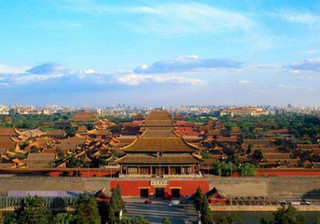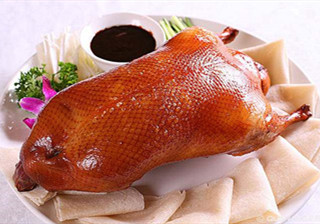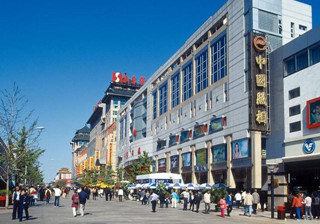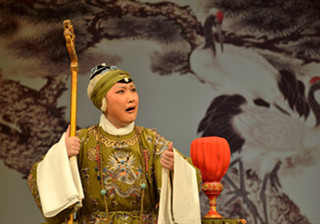- 86-15907880780
- contact@youngchinatravel.com
Beijing is the capital of the People's Republic of China and one of the country's three municipalities under direct central authority. To the northwest stands a chain of lofty mountains with the Great Wall snaking through its peaks and to the southeast lays a broad expanse of rolling plain. Situated in the north of Hebei Sheng (Hopei Province), Beijing covers an area of 6,870 sq. mi. (17,000 sq. km.) with a population totaling over 21.54 million people.
Content
- Must-see Attractions in Beijing
3. Beijing Characteristic Tourism
5. What to Eat in Beijing – Beijing Cuisine
7. Beijing Entertainment and Nightlife
Beijing is a city with a long history. In 1929 the first fragment of a skull of  what was later termed "Peking Man" was uncovered 29 mi. (48 km.) southwest of the City, verifying civilization at Beijing goes back 400 to 500 thousand years. Over the centuries the City has had many names, serving as China's capital off and on throughout history. The Great Wall, one of the world's most famous sites, was constructed during the Qin (Chin) Dynasty, 221-206 B.C., to protect the capital against invaders. Early in the tenth century Beijing lost some of its stature when the northern conquerors called it Nan Jing (Southern Capital) to distinguish it from their new capital which had been established north in Manchuria. In the twelfth century it was renamed Zhong Du (Central Capital) and enlarged in three directions.
what was later termed "Peking Man" was uncovered 29 mi. (48 km.) southwest of the City, verifying civilization at Beijing goes back 400 to 500 thousand years. Over the centuries the City has had many names, serving as China's capital off and on throughout history. The Great Wall, one of the world's most famous sites, was constructed during the Qin (Chin) Dynasty, 221-206 B.C., to protect the capital against invaders. Early in the tenth century Beijing lost some of its stature when the northern conquerors called it Nan Jing (Southern Capital) to distinguish it from their new capital which had been established north in Manchuria. In the twelfth century it was renamed Zhong Du (Central Capital) and enlarged in three directions.
In the thirteenth century fighting destroyed most of Zhong Du. Kubla Khan called the new city he established nearby Da Du (Great Capital). At the beginning of the Ming Dynasty, 1368 A.D., Nanjing (Nanking) became China's capital until the early 1400's when the capital was again moved back to Beijing. During this dynasty the Great Wall was restored.
Beijing remained the capital for almost seven centuries and was witness to many historical events, one of the most famous of which is called the "May 4th Movement." On May 4, 1919, over 300,000 people demonstrated in Tian’anmen Square. This demonstration, organized by students from Beijing University, was staged to protest their displeasure with the current government. This movement has been called by many as the beginning of China's search of independence.
In 1928 the political seat was moved to Nanjing (Nanking). But Beijing was restored to its former stature as China's capital when on October 1, 1949, Chairman Mao raised the red flag of China from Tian’anmen Sqaure, the inaugural ceremony signifying the founding of the People's Republic of China.
So many scenic places and historical sites here in Beijing left by her capital history over several thousand years. Visitors always say: He who hasn’t been to the Great Wall is not a true man; I have to see Palace Museum firstly once come to Beijing; I properly comprehend that “Heaven is round,Earth is square ” only after I come to Beijing! Her ancientness, her abundance and profundity’ her long history and contemporary, her traditional and pluralistic characteristic civilization could only be understood after you have visited all these scenic spots !
Beijing used to be the capital city for five dynasties. During over 800 years starting from the Jin Dynasty (1115-1234A.D), a large number of majestic and magnificent palace architectures had been constructed, which has made Beijing a city with the most imperial palaces, gardens, temples, altars and mausoleums and a city with the richest connotation in our country.
Beijing Alley, one of the local-style dwelling houses, originates from the Yuan Dynasty. "Hu-tong" in Mongolian means "back street or lane" . The city of Beijing is star-studded with more than 7,000 alleys large or small, and each has its own anecdote.
The Courtyard House, as its name suggests, is a compound with houses on all sides around a square courtyard whose outer walls make up the sidewalls of the alley. The northern inner houses are the principle rooms, while the eastern and western are wing-rooms. There is no window or pass but a front gate leading to the alley. The serene and secluded courtyard house is a traditional kind of dwelling houses for old Beijing.
Beijing is well known as a cultural center and as the home of the famous "Peking Opera." Traditional arts and crafts still flourish including ivory sculpture, jade carving, carpets, embroidery, cloisonné, and lacquer ware. Beijing also boasts many theaters and movie houses, China's largest library, and many colleges and universities, including Beijing University, founded in 1898, and Qinghua (Tsinghua)University, famous for its scientific and technical research.
One Day Beijing Must-See Tour - In one day visit the Forbidden City, Tian'anmen Square, Mutianyu Great Wall. These are the must-see sites in Beijing, so you can get to know some of Beijing's beautiful buildings.
3 Days Beijing Visa Free Tour - This tour is also a good choice for travellers who want to take advantage of the 144-hour Visa Free transit.
4 Days Beijing Classic Tour - It is designed for travelers who want to experience the ancient and modern capital city of Beijing.
8 Days China Golden Triangle Tour - This tour is recommended for travelers who come to China for the first time, which includes three of the most popular tourist destinations in China.
Beijing Cuisine, or "Jing Cuisine" for short, blends the cooking  techniques of Han, Manchu, Mongolian, Hui and other ethnie groups, and absorbs the advantages of various local schools of cuisine in South and North China, such as Shandong Cuisine. After a long-lasting development, Beijing Cuisine with the local characteristics was formed.
techniques of Han, Manchu, Mongolian, Hui and other ethnie groups, and absorbs the advantages of various local schools of cuisine in South and North China, such as Shandong Cuisine. After a long-lasting development, Beijing Cuisine with the local characteristics was formed.
Though not very large, Beijing is the capital of China, as well as the country's political, economic and cultural center. Accordingly, Beijing exerts great influence on the entire country, so does Beijing Cuisine. For instance, Beijing Roast Duck is well known both at home and abroad. Situated at the northern end of the North China Plain, Beijing is a famous city with the longest history, and one of the ancient capitals in China. After the Spring and Autumn period (770-221 B.C.) and the Warring States period (770-476 B.C.), Beijing served as the capital for six dynasties, totaling over 800 years. Before the Song Dynasty, Beijing was not prosperous. In the Yuan Dynasty, Beijing became the capital of the largest country in the world; and according to the description by Marco Polo, Beijing was No. 1 metropolis in the world. At that time, the most citizens in Beijing used coal as fuel, creating conditions for the development of the catering trade. In the Ming and Qing dynasties, Beijing became more prosperous thanks to the construction over past several hundred years. With the passage of time, more and more officials moved from South China to Beijing, making the cuisine of South China occupy a small position in the capital.
Of all the local schools of cuisine in Beijing, Shandong Cuisine has exerted the most remark-able influence on Beijing Cuisine, and occupies an important position in Beijing's folk diet and catering trade. In addition, the influence of court cuisine, official cuisine and Muslims' cuisine of the Hui people on Beijing Cuisine was also very obvious. Under this circumstance, Beijing Cuisine was gradually formed.
Beijing Cuisine integrates the cooking techniques of Han, Manchu, Mongolian, Hui and other ethnic groups; absorbs the good qualifies of ail the main local schools of cuisine in South and North China, especially the most advantages of Shandong Cuisine; and inherits some cooking techniques of court cuisine and official cuisine of the Qing Dynasty. On this basis, various local dishes with distinct characteristics of Beijing were created. Now Beijing Cuisine embraces a wide variety of meticulously prepared dishes and snacks, which are soft, crisp, fresh, tender and delicious.
Sweets: ludagun (donkey rolling on the ground, a soft layered roll), wandouhuang (pea flour cakes), Aiwowo (steamed rice cake with sweet filling), yundoujuan (kidney bean roll), Mimahua (honey-fried dough twists), Kaikouxiao (laugh mouth, concave size pancake)
Cold food: pagao (buckwheat pancakes), suanmeitang (sour cherry soup), hongguolao (Red fruit jelly), liangfen (cool bean jelly)
Baked: mianbobo(flour cakes), nushebing (beef tongue size pancake), roasted sweet potatoes
Deep-Fried: baocui (thin crisp), jiaoquan (fried dough rings), zhagao (fried cakes), chunjuan (spring roll), matuan ( sesame balls), paicha (fried flour ribs)
Fried: guotie (fried dumplings), dalian huoshao (flake cakes)
Hot pot: douzhi (mung bean milk), fried meat balls, millet flour gruel, stur-fried liver, flash-fried tripe
Beijing preserved and candied fruits, chestnuts from Liangxiang,  Beijing white pear, little red dates from Miyun, big walnuts from Mentougou, Damopan persimmons, Beijing roasted duck, tuckahoe with glutinous rice paper, Liubiju pickles, and Angong pills.
Beijing white pear, little red dates from Miyun, big walnuts from Mentougou, Damopan persimmons, Beijing roasted duck, tuckahoe with glutinous rice paper, Liubiju pickles, and Angong pills.
The four famous articles of arts and handicrafts in Beijing are cloisonne, ivory carvings, jade articles and carved lacquer wares. There are other exquisite and diversified wares, like metal and stone seal cuttings, four treasures in study-room (writing brush, ink stick, ink slab, and paper), antiques, silk and embroidery and jewelries. Such wonders of Beijing City as dough figurine, clay figurine, silk figurine, opera facial make-up, kites and paper-cut are all best choices for those who prefer folk handicrafts. Musical instruments produced in Beijing are of high standard, so some tourists will purchase a Chinese traditional musical instrument either for learning to play or for decoration. Besides, visitors can also try the characteristic local food such as preserved candied fruits or the traditional herbal invigorants in Beijing.
Qianmen Avenue
Here you can visit Liubiju Grocery of Fermented Paste, Tongrentang Drugstore, Ruifiixi-ang Silk Store, Neiliansheng Shoe Store, Zhang Yiyuan Tea House, Yueshengzhai Sauced Beef Store, Zhengmingzhai House of Pastries (Beijing Style), Douyichu Snack Bar (famous for its Shao Mai), Xinxin Clothing Store (the largest one in Beijing), No.l Dazhalan Department Store, No.2 Dazhaian Department Store, Ladies' Store, Children' s Store, Qianmen Business Mansion, Ren-ren Hotel. At the western side are the newly-built Zhengyang Square, Laoshe Tea House and Kentucky Fried Chicken Restaurant.
Wangfujing Avenue
It is the most famous commercial street that has a  history of nearly 100 years in Beijing. On the west side of the avenue is the well-known Beijing Department Store, while on the east is the noted Xindong' an Market. The avenue converges a lot of large-scale exclusive shops such as the largest store of crafts and arts in China, the largest Xinhua Bookstore and Foreign Language Bookstore nationwide, Chinese Photo Studio- also the largest domestic one, Lisheng Sporting Goods Center, Medical Equipment Store, Wangfujing Shopping Center and Muslim Trade Mansion. Additionally, many characteristic restaurants and groceries gather here, like Beijing Roasted Duck Restaurant, Wufangzhai (Five Fragrance Grocery), Quan-suzhai (Vegetarian Food Grocery), Puwufang Restaurant and Donglaishun Restaurant. Furthermore, there are plenty of time-honored shops and new shops with special business traits, e.g. Shengxifu Hat Store, Tongbihe Shoes Store, New World Silk Store, Precious Materials Drugstore, Bichun Tea Leaf Store, Jiguge Antique Store, etc. All the stores in different trades win their high reputation for their own business features.
history of nearly 100 years in Beijing. On the west side of the avenue is the well-known Beijing Department Store, while on the east is the noted Xindong' an Market. The avenue converges a lot of large-scale exclusive shops such as the largest store of crafts and arts in China, the largest Xinhua Bookstore and Foreign Language Bookstore nationwide, Chinese Photo Studio- also the largest domestic one, Lisheng Sporting Goods Center, Medical Equipment Store, Wangfujing Shopping Center and Muslim Trade Mansion. Additionally, many characteristic restaurants and groceries gather here, like Beijing Roasted Duck Restaurant, Wufangzhai (Five Fragrance Grocery), Quan-suzhai (Vegetarian Food Grocery), Puwufang Restaurant and Donglaishun Restaurant. Furthermore, there are plenty of time-honored shops and new shops with special business traits, e.g. Shengxifu Hat Store, Tongbihe Shoes Store, New World Silk Store, Precious Materials Drugstore, Bichun Tea Leaf Store, Jiguge Antique Store, etc. All the stores in different trades win their high reputation for their own business features.
Xidan Commercial Street
This is a prosperous commercial street that has survived and developed in fierce competition. It is lined with the newly-built cultural square, the famous Zhongyou Department Store, the Time Square, Saite Shopping Center of Xidan, Xidan Department Store, Xidan Shopping Center, and many other new and time-honored stores, with some new shops like Biological Products Store, Bedding Articles Store, and Dishware Store and the time-honored shops represented by Shengxifu Hat Store, Wanli Shoes Store, Jingyi Eyeglasses Store and Hendry WatchStore. In recent years the district has opened a night fair. The hustling and bustling street is still in its process of growth.
Xiushui Street
Xiushui Street is a perfect place for buying cheapies. The street is near the embassy district. During weekends, foreign residents in Beijing will usually come here for a walk , just for practicing Chinese with the booth owners who can speak a pure Beijing dialect. This "Flee Market" of clothes, though only over 100 meters long, enjoys a high reputation abroad and becomes a must for foreign visitors during their stay in Beijing.
There are various kinds of cultural recreational forms in Beijing, as the city includes theaters, teahouses, cinemas, ballrooms, gyms, swimming pools and golf courses, suitable for both Chinese and foreign tourist.
As most of metropolises in the world, the night in Beijing is specifically charming, being far from the noisy day time, getting rid of the crowded traffic and loud streets and lanes,it then turn to fascinating night lamps brightening with fluttering dress. The night of Beijing is really colorful: you may take a walk along Shichahai; drink in music halls; taste delicious meals in the Gui Street; drink in the bars, dance in the balls until perspiration or wandering in the streets. All decisions depend on your wish.

Peking Opera is the quintessence of Chinese culture. With a history of over 200 years, Peking Opera is the most popular of many forms of traditional opera in China. It is performed through singing, speaking, dancing, acrobatics and martial arts. The types of role of Peking Opera fall into sheng(male role), dan(female role),jing (painted faces), and chou(clown). In Beijing today, people can also appreciate Peking Opera with national characteristics
Acrobatics is one of the oldest per- forming arts in China. Over the past 2, 000-some years, Chinese acrobats have created many classic items, such as "wire-walking “ head feats,"“ ancient magic", conjuring, etc. Chinese acrobat-iCS have been warmly received by tourists from all over the world.
In Beijing, it is quite fashionable to go to a traditional teahouse for some old-fashioned tea-appreciation. The atmosphere in teahouses is usuall calm and tranquil. Some teahouses offer performances of traditional opera, folk-custom or tea ceremony. This is a nice way to enjoy your time in Beijing.